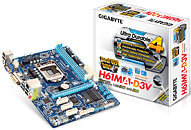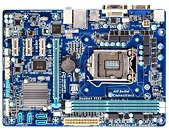- Joined
- Oct 9, 2007
- Messages
- 47,527 (7.48/day)
- Location
- Hyderabad, India
| System Name | RBMK-1000 |
|---|---|
| Processor | AMD Ryzen 7 5700G |
| Motherboard | ASUS ROG Strix B450-E Gaming |
| Cooling | DeepCool Gammax L240 V2 |
| Memory | 2x 8GB G.Skill Sniper X |
| Video Card(s) | Palit GeForce RTX 2080 SUPER GameRock |
| Storage | Western Digital Black NVMe 512GB |
| Display(s) | BenQ 1440p 60 Hz 27-inch |
| Case | Corsair Carbide 100R |
| Audio Device(s) | ASUS SupremeFX S1220A |
| Power Supply | Cooler Master MWE Gold 650W |
| Mouse | ASUS ROG Strix Impact |
| Keyboard | Gamdias Hermes E2 |
| Software | Windows 11 Pro |
After trying to avoid UEFI BIOS by sticking to "HybridEFI" workarounds to its existing AwardBIOS code on most of its socket LGA1155 and AM3+ motherboards, GIGABYTE reluctantly transitioned to UEFI with its socket LGA2011 motherboards, on which it fused its innovative Dual-BIOS technology with UEFI to come up with Dual-UEFI technology. One can imagine this to be particularly tough to implement on lower-end models, since UEFI with graphical setup program requires higher-capacity EEPROM chips, and since Dual-UEFI would need two, it would stress component costs, but GIGABYTE did it anyway.
In Japan, the company released the latest revision of the GA-H61MA-D3V (rev. 2.0), an entry-level socket LGA1155 motherboard based on the Intel H61 chipset, which features Dual-UEFI. Apart from this, the board also features GIGABYTE's Ultra-Durable 4 Classic component loadout, which consists of a new fiberglass fabric weave PCB that's more resistant to humidity that causes short-circuits, high ESD-resistance ICs, anti-surge ICs located on critical circuits, low RDS (on) MOSFETs, and a 100% high-grade solid-state capacitor design.


The CPU is powered by a 5-phase VRM, it is wired to two DDR3 DIMM slots supporting up to 16 GB of dual-channel DDR3 memory. Expansion slots include one PCI-Express 3.0 x16, and three PCIe x1. The move to exclude legacy PCI is not only progressive, but could also save GIGABYTE the cost of placing a PCI-PCIe bridge chip. Storage connectivity includes two SATA 6 Gb/s ports from Marvell 88SE9172 (since H61 PCH lacks SATA 6 Gb/s), and four SATA 3 Gb/s ports from the PCH. Other connectivity includes 6-channel HD audio (driven by Realtek ALC887), two USB 3.0 ports (driven by EtronTech EJ168), gigabit Ethernet (driven by Realtek 8111E), and a number of USB 2.0 ports. Display connectivity includes DVI and D-Sub
Slated for May, the GA-H61MA-D3V 2.0 will cost about US $50.
View at TechPowerUp Main Site
In Japan, the company released the latest revision of the GA-H61MA-D3V (rev. 2.0), an entry-level socket LGA1155 motherboard based on the Intel H61 chipset, which features Dual-UEFI. Apart from this, the board also features GIGABYTE's Ultra-Durable 4 Classic component loadout, which consists of a new fiberglass fabric weave PCB that's more resistant to humidity that causes short-circuits, high ESD-resistance ICs, anti-surge ICs located on critical circuits, low RDS (on) MOSFETs, and a 100% high-grade solid-state capacitor design.


The CPU is powered by a 5-phase VRM, it is wired to two DDR3 DIMM slots supporting up to 16 GB of dual-channel DDR3 memory. Expansion slots include one PCI-Express 3.0 x16, and three PCIe x1. The move to exclude legacy PCI is not only progressive, but could also save GIGABYTE the cost of placing a PCI-PCIe bridge chip. Storage connectivity includes two SATA 6 Gb/s ports from Marvell 88SE9172 (since H61 PCH lacks SATA 6 Gb/s), and four SATA 3 Gb/s ports from the PCH. Other connectivity includes 6-channel HD audio (driven by Realtek ALC887), two USB 3.0 ports (driven by EtronTech EJ168), gigabit Ethernet (driven by Realtek 8111E), and a number of USB 2.0 ports. Display connectivity includes DVI and D-Sub
Slated for May, the GA-H61MA-D3V 2.0 will cost about US $50.
View at TechPowerUp Main Site


 this kinda sorta might be overkill for a board of this category but it's cool none the less.
this kinda sorta might be overkill for a board of this category but it's cool none the less.